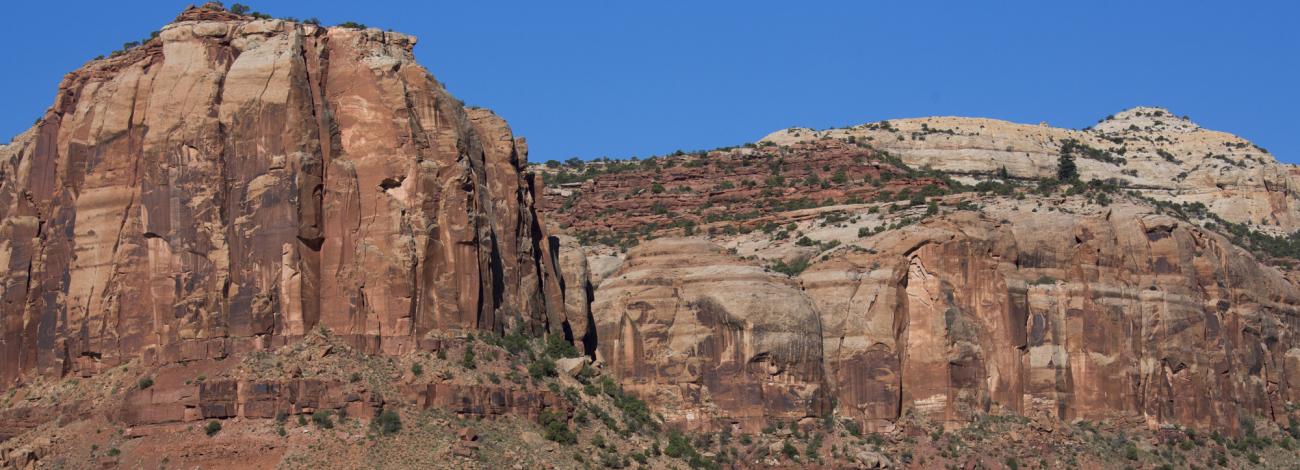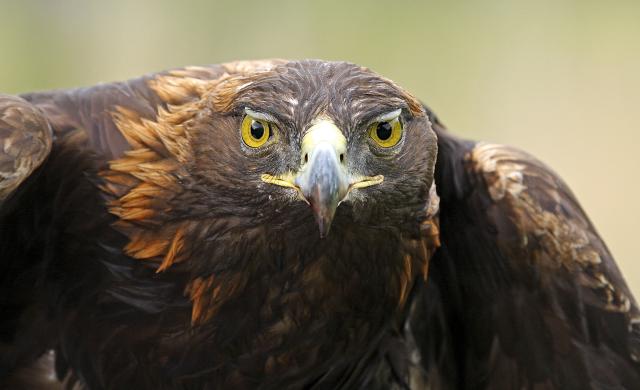
Voluntary climbing closures critical for avian wildlife
Each spring, BLM’s Monticello Field Office staff ask climbers to voluntarily avoid routes near historic nesting sites in Indian Creek.
In 2024, we confirmed the presence of both golden eagles and peregrine falcons in the area and by summer we had successful fledging of chicks on two prairie falcon nests and one golden eagle nest. All three nests were located on or very near popular climbing areas. Fledging is the stage in development where young birds get their flight feathers and can begin to leave the nest as they practice flying, marking the end of nesting season, and signaling that it is time to welcome climbers back to the cliffs to enjoy the world class climbing routes in and around Indian Creek.
Asking climbers to avoid the cliffs is all about minimizing disturbances during crucial egg incubation and brood rearing periods for falcons, eagles and other raptors — ensuring these species have all of the opportunities to successfully rear their young. This is why we are so grateful for those who voluntarily climb elsewhere during the spring and summer.
Wildlife biologists monitor active nests weekly throughout the season, compiling important data and reference points for research and documentation moving forward.
Golden eagles
Golden eagles are protected under the Migratory Bird Treaty Act and the Bald and Golden Eagle Protection Act. They are the second largest North American raptor species — Bald Eagles are the first. They boast a 7-foot wingspan and set of talons capable of exerting 500-800 pounds of pressure. They can fly hundreds of miles in a single day and reach speeds of 150mph in a dive.
Golden eagles are apex predators, preying on small animals like mice and jackrabbits, and opportunistically tackling larger hoofstock species like pronghorn and deer. Some have even been seen swooping, grabbing and releasing large prey off of steep cliffs, or gliding through canyons with them in tow.
The Utah population of golden eagles has been dropping since 2007; this is believed to be due to the decline of their preferred prey species — jackrabbits. Golden eagles are also susceptible to lead poisoning from scavenging carcasses. Hunters sometimes leave their kill and/or gut piles peppered with lead bullet fragments, and the birds eat the contaminated meat. Understandably, they capitalize on the easy opportunity to eat. This lead-poisoning can lead to the death of the bird or the thinning of egg shells, potentially killing the chicks.
Prairie and peregrine falcons
Prairie and peregrine falcons, both protected under the Migratory Bird Treaty Act, are equally talented hunters. Prairie falcons are a desert-adapted species — having no qualms aggressively pursuing small mammals and reptiles, in addition to typical avian prey species preferred by peregrines.
Both species can fly 70 miles per hour and reach 200 miles per hour in a dive! They are known for their agility and ability to catch other birds midair.
The prairie falcons' tendency to eat mammalian prey helped keep their populations from crashing from dichlorodiphenyltrichloroethane (more commonly known as DDT) exposure in the 1970s. DDT an insecticide banned by the Environmental Protection Agency in 1972. Often, mammals tended to have less contamination from the pesticide. However, waterfowl, which are a frequent prey of peregrine falcons, unintentionally consumed more of the pesticide, which would collect easily in their wetland environment. This caused weak eggshells and bones in peregrine falcons, leading to populations to decline to critically low levels resulting in needing to be listed as an endangered species.
Prairie falcons, like their cousins the peregrine falcon, also have suffered negative effects due to DDT contamination, but to a lesser extent. While there had been population decline, numbers of this species quickly rebounded and stabilized after the banning of the pesticide. Peregrines also recovered and where delisted in 1999.
With protections in place and volunteers willing to respect their breeding/brood rearing season, the future looks bright for these two species!
For questions about raptors, please contact BLM Wildlife Biologist Melissa Wardle. For questions about climbing and recreation in the Indian Creek area, please contact Indian Creek Ranger Jeff Walsh. Both may be reached at the Monticello Field Office at 435-587-1500.



